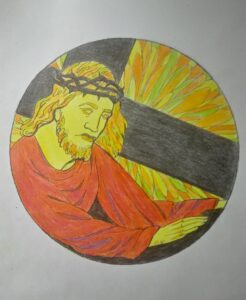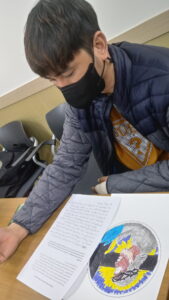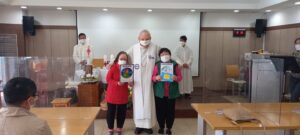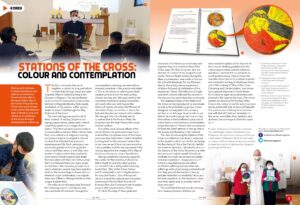During Lent last year, Fr Jason Antiquera was able to recommence his art ministry after a two-year hiatus due to the Covid-19 pandemic. Those who participated in his Lenten Recollection were invited to pray and reflect on the Stations of the Cross through contemplative colouring.
The first community that came together in person to pray and reflect on their faith through visual arts were migrants: Filipino Catholics living in the Diocese of Daejeon. This was facilitated by Columban Fr Jude Genovia who works full-time in Migrants Ministry. Participants meditated on the passion, suffering and death of Jesus Christ through the Way (Stations) of the Cross.
The methodology was new for all of them. Instead of reading Scripture and saying prayers aloud, participants instead prayerfully gazed on an image of each station. They then applied colours slowly in a contemplative manner. While colours have their own cultural and religious meaning, participants were encouraged to choose a colour that reflected their personal experience and life. Each participant was personally guided on how to apply the colours and they came up with their own palette of colours which they applied to a moment in Christ’s passion and death that resonated with their own faith journey.
Each one followed their own pace, pulse and strokes in the colouring process. As a result, while two people may have opted to work on the same image and even with an identical colour combination, the outputs were very different, distinguishable by their unique brushstrokes.
The reflection and sharing that followed the colouring was rich and diverse and resonated with all involved. Through this contemplative colouring, we were able to immerse ourselves in the passion and death of Christ. Sensitivity to suffering and death caused some to burst into tears as they shared.

A sample page of the Korean language version of ‘Way of the Cross: Colouring and Contemplation’.
But they also felt supported by the workshop community as they connected with each other and with figures like Simon of Cyrene, Veronica, the Women of Jerusalem, Mary the mother of Jesus, the beloved disciple, and Joseph of Arimathea. We also got in touch with that part of ourselves that is like Pontius Pilate, the pharisees and the High Priests, the crowd and the soldiers.
One of the most obvious effects of the art recollection for participants was that it enabled them to release some of the heavy emotions they had locked inside themselves. Looking back on the process, I realise that in our lives we each have our own individual colour palettes and this was expressed in the colours applied to the images of the Way of the Cross during our Lenten Recollection.

Guidelines in the Korean language version of ‘Way of the Cross: Colouring and Contemplation’.
Having created the colouring pages for the Lenten Art Recollection, it struck me that it might be useful to other groups, so I turned it into a self-guided colouring book titled, ‘Way of the Cross: Colour and Contemplation’ with a digital version for easy distribution. One of those with whom I shared the material was Columban missionary Fr Noel O’Neill, founder of Emmaus Rainbow Community which assists people with special needs in Korea.
On Holy Thursday, Fr Noel gathered members of the Emmaus community and together they coloured their Way of the Cross. Later, Dr Chun Yung Hui, who is a director of a school of art, judged the art works. Then on Easter Sunday during the Mass, a presentation was made to honour the colourful drawings. For our Emmaus friends, the activity was an experience of labour followed by celebration of the resurrected Christ. The reflection of bright and warm colours reflected the colours in the rainbow that symbolises the community.

Participant colouring the Way of the Cross and writing his reflection.
The digitised copies of the Stations of the Cross can be reproduced by individuals as well as those facilitating groups. It was designed in a way that it can be easily printed on an A4 page. Anyone who is not able to do it with a group can thus do it by themselves in their preferred space and at a time that is convenient as a contemplative prayer through art. There is also no pressure to finish the entire stations in one go, that is the beauty and flexibility of the material.
The idea of colouring the Stations of the Cross as a reflection was done in response to the question: what can I do for our Lenten Art Recollection? Since the Catholic faithful are drawn to devotion, I decided to work on the Stations of the Cross. However, it is often too wordy, so I asked myself: how do we meditate on it with less words and instead immerse ourselves in image and colour? Is there a way that people can reflect on Christ’s suffering and also their own sufferings without becoming overwhelmed? Can they ground themselves in beauty and also hold their vulnerability? How can I facilitate people to do the devotion in their own time, space and, to a certain extent, their own way?

Members of the Emmaus Rainbow Community finished their Way of the Cross workshop on Holy Thursday and Columban Fr Noel O’Neill presented awards on Easter Sunday.
The work that followed was demanding: from drawing fourteen different yet harmonised templates of the Stations of the Cross to drafting guidelines for the colouring procedure and the reflection questions. I wanted it to be available as a self-guided activity. I have chosen the mandala shape due to its spiritual character and universal meaning of wholeness. Every part of the making of ‘Way of the Cross: Colouring and Contemplation’, was driven by a pastoral response to God’s desire for humans to experience wholeness and renewal of life beyond the cross.
The colour palette we choose to fill the Way of the Cross is the colour of our life and of our very selves united with that of Jesus of Nazareth. Our passion and suffering have become one with that of Christ our redeemer. In this sense, even difficulties, hardship and darkness become ways to God who saves us.
Fr Jason Antiquera is a Columban missionary from Binalbagan, Negros Occidental in the Philippines. He spent time in Korea and Peru as a seminarian. Ordained in 2015, he then went on mission to Korea where he has since worked to share the mission of God and the Gospel of joy through Art Ministry.
This article was published in the March/April 2023 issue of the Far East magazine. Annual subscription is just €10 for digital or €20 for print. Please subscribe here: https://columbans.ie/product/far-east-magazine-yearly-subscription/


